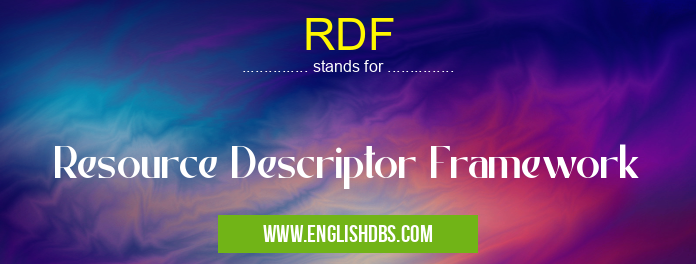What does RDF mean in UNCLASSIFIED
Resource Description Framework (RDF) is a model for organizing and expressing data in the form of statements. It is used to represent, formally describe, and interchange knowledge on the World Wide Web (WWW). RDF allows software to search and interpret data across multiple sources—including local databases, websites, documents, emails, and other media—in an efficient way. RDF represents information as a graph or network of statements about resources on the web. Each statement or relationship between two resources is represented as a “triple” composed of the subject (which resource it is about), predicate (the type of relationship), and object (the value that supports that relationship). This way, information on the web can be connected in meaningful ways for easier access and use.

RDF meaning in Unclassified in Miscellaneous
RDF mostly used in an acronym Unclassified in Category Miscellaneous that means Resource Descriptor Framework
Shorthand: RDF,
Full Form: Resource Descriptor Framework
For more information of "Resource Descriptor Framework", see the section below.
Essential Questions and Answers on Resource Descriptor Framework in "MISCELLANEOUS»UNFILED"
What is RDF?
Resource Descriptor Framework (RDF) is a language for creating and sharing data over the World Wide Web. It enables anyone to make statements about resources, such as documents, images, people, and websites. RDF stores these statements in a graph structure that can be easily shared with others.
How is RDF used?
RDF is often used to represent data from various sources as a single unified dataset. This gives developers an easy way to access all of their data from one place, rather than having to query each source separately. It also helps developers create applications that can understand the structure and meaning of the data being provided.
What are the benefits of using RDF?
Using RDF has several benefits. It enables data sharing between different systems and encourages creativity within developers when building applications on top of it due to its flexibility. Additionally, it provides a platform for linking together disparate datasets and knowledge bases which could otherwise remain siloed off from one another.
What languages are used with RDF?
The main languages used with RDF are XML, Turtle, N-Triples, JSON-LD and RDFa. Each language has its own strengths depending on the type of application being developed. XML is good for developing complex data structures while Turtle is best for developing simpler ones; similarly JSON-LD and RDFa offer more readable syntax over basic N-Triples representations.
Are there tools available for working with RDF?
Yes, there are many open source tools available to work with RDF including Apache Jena Fuseki, Sesame Workbench and RaptorDBMS among others. These tools enable developers to quickly build applications dealing directly or indirectly with the framework since they already contain built-in libraries dealing with different aspects such as querying or visualizing data.
Does everyone use the same version of RDF?
No, there are multiple versions of the framework which have been created over time in order to address different needs from different user communities or accommodate improvements made by W3C (World Wide Web Consortium). The most commonly used versions are currently 1st Edition (1999), 2nd Edition (2008) and 3rd Edition (2014).
Why should I use ontology with my resource descriptor framework application?
Ontologies provide additional semantic information about your resources which can be useful when looking for specific pieces of information within them or linking them together in order establish relationships between them that weren’t previously established before hand.
What other technologies integrate well with an RDf based application or platform?
Technologies such as SPARQL Query Language (SPARQL) are used frequently alongside an RDf based application since they help process queries involving datasets stored within an RDf format more efficiently than using plain language alone; OWL (Web Ontology Language) was also designed specifically to work closely within this type of environment.
Final Words:
RDF provides the web with a powerful framework for managing its vast stores of information more efficiently. By providing structure to information, it helps developers craft more effective applications that can quickly analyze and connect relevant pieces of data from multiple sources simultaneously. Furthermore, with its consistent standard right down to the individual piece of information, it facilitates easier sharing across platforms while ensuring higher quality results regardless of where the data originated from.
RDF also stands for: |
|
| All stands for RDF |
